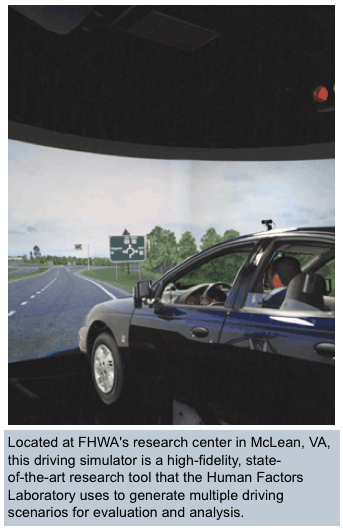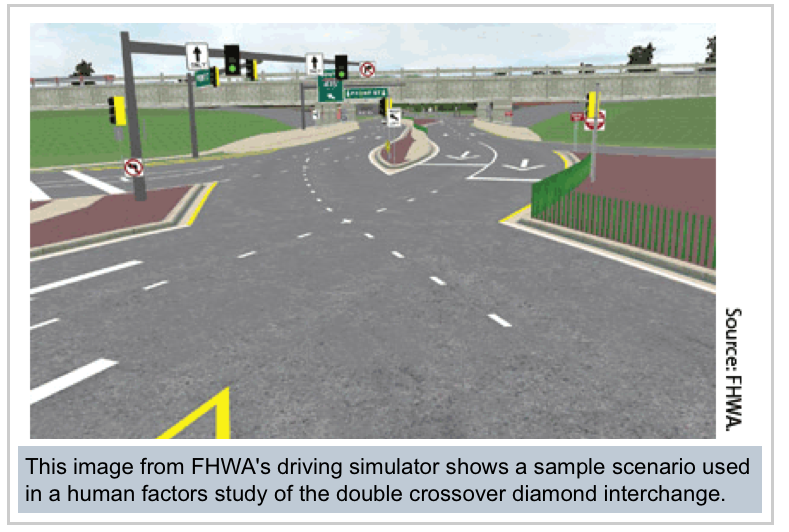FEDERAL HIGHWAY ADMINISTRATION
by C. Y. David Yang, Jim Shurbutt, and Brian Philips
 In recent years, national attention toward the issue of driver distraction has increased among the transportation community, the media, and the public. Texting and cell phone use while driving, for example, are major safety concerns due to their role as contributing factors in a growing number of vehicle crashes. But roadway and roadside infrastructure also can contribute to driver distraction. For example, does the placement of changeable message signs at certain locations cause motorists to look away from the road more than they would otherwise? Do certain sign messages cause driver confusion or misunderstanding?
In recent years, national attention toward the issue of driver distraction has increased among the transportation community, the media, and the public. Texting and cell phone use while driving, for example, are major safety concerns due to their role as contributing factors in a growing number of vehicle crashes. But roadway and roadside infrastructure also can contribute to driver distraction. For example, does the placement of changeable message signs at certain locations cause motorists to look away from the road more than they would otherwise? Do certain sign messages cause driver confusion or misunderstanding?
To answer questions like these, the Federal Highway Administration’s (FHWA) Human Factors Laboratory, located at the Turner-Fairbank High-way Research Center (TFHRC) in McLean, VA, helps FHWA and its partners examine strategies for enhancing the operation and safety of the Nation’s highways. The laboratory has a long history of carrying out research to further understanding of the needs and limitations of transportation users. Based on the research findings, FHWA has developed guidance, for example, to optimize the design and placement of traffic signs at freeway interchanges and intersections to communicate critical information to drivers more effectively.
Understanding the capabilities and limitations of travelers can help engineers design roadways to minimize human errors and enhance the safety of the traveling public. Research on user characteristics can lead to improvements in roadway design, construction, and maintenance that will enable the transportation system to operate more efficiently and safely.
“The Human Factors Laboratory employs multiple research tools to help transportation practitioners evaluate various roadway designs before building them,” says FHWA Associate Administrator Michael Trentacoste, Office of Research, Development, and Technology. “For example, State departments of transportation [DOTs] that plan to implement new interchange designs, such as the diverging diamond interchange [also known as the double crossover diamond] and the restricted crossover U-turn, can create virtual interchanges using the lab’s modeling software to conduct detailed analyses of these designs and others like them. FHWA and its partners will continue to use this state-of-the-art research facility to carry out important human factors and driver behaviors studies.”
Recent improvements in the various tools employed by the Human Factors Laboratory, along with a sample of projects that have employed those tools, illustrate how the lab’s research continues to benefit motorists and other users of the transportation network. But first, a quick look at how the Human Factors Laboratory came about.
The Lab’s Back Story
To understand the needs and limitations of transportation users, FHWA began conducting human factors and driver behavior studies in the 1960s when the agency was known as the Bureau of Public Roads, a division of the U.S. Department of Commerce. Two researchers with the Bureau of Public Roads, R. M. Michaels and B. W. Stephens, published a journal article in a 1963 issue of the Highway Research Record (predecessor of Transportation Research Record: Journal of the Transportation Research Board) titled “Driver Characteristics, Night Visibility, and Driving Simulation.” The article described the use of a simulation experiment at the Bureau of Public Roads’ laboratory to study driver performance by tracking activities such as eye movements.
Another example of FHWA’s ongoing support of human factors research related to transportation is a 1981 article by D. A. Gordon. This article, published in Public Roads, described several studies that examined the design of roadway signs using human factors principles, such as applying a correct legibility ratio on sign letters to help drivers read and understand these signs from a distance.
In subsequent years, FHWA’s human factors team, with support from onsite technical contractors, have performed numerous studies using a variety of research tools to gain better understanding of the capabilities and limitations of drivers in the context of transportation infrastructure and improvements to enhance travel safety.
Driving Simulator
One of the research tools employed at the Human Factors Laboratory is a driving simulator used for a vari–ety of behavioral studies related to safety and operations conducted for FHWA and other stakeholders. The simulator consists of a full automobile chassis surrounded by a semi-circular projection screen. Five projectors render a seamless 240-degree view (motorists’ field-of-view) of high-fidelity, computer-generated roadway scenes.
Read full report: Why Drivers Do What They Do
About the Federal Highway Administration
www.fhwa.dot.gov
“The Federal Highway Administration (FHWA) is an agency within the U.S. Department of Transportation that supports State and local governments in the design, construction, and maintenance of the Nation’s highway system (Federal Aid Highway Program) and various federally and tribal owned lands (Federal Lands Highway Program). Through financial and technical assistance to State and local governments, the Federal Highway Administration is responsible for ensuring that America’s roads and highways continue to be among the safest and most technologically sound in the world.”
Tags: Driving Simulator, Federal Highway Administration, FHWA







 RSS Feed
RSS Feed